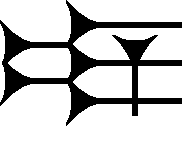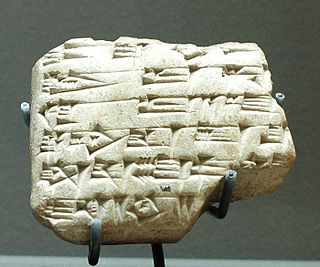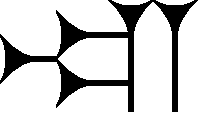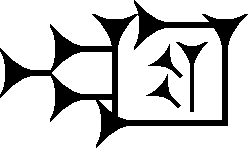
The cuneiform as sign, also aṣ, and az, is found in both the 14th century BC Amarna letters and the Epic of Gilgamesh. As as and az in the Amarna letters it appears identical in form in both Amarna letters EA 365, and EA 362. In the photo of the bottom half of Amarna letter EA 365, it is used to name the workers as: LÚ-MEŠ-(plural)–ma-as-sà-meš-(plural), (amēlu-massu)

The cuneiform sign KÁ, for gate is the Sumerogram-(logogram) used in the Amarna letters and the Epic of Gilgamesh; as just KÁ it means "gate" or "doorway", Akkadian language, "bābu"; as "Gate-Great", KÁ.GAL for City-Gate, it is from Akkadian "abullu",. Both uses are in the Epic of Gilgamesh. In the Epic, it is only used as the sumerogram, a total of 19 times,. In the Epic, all spellings for city gate use KÁ.GAL; for gate ('bābu') only one spelling uses the alphabetic letters for b-a-b-u; the rest use KÁ along with other added cuneiform signs.

The cuneiform sign for tur is used to denote one syllabic usage, tur, or the sign's Sumerograms; it is used in the Epic of Gilgamesh and the 14th century BC Amarna letters. The sign is based on the i (cuneiform) sign, with the one small added vertical stroke.

The cuneiform Aš sign, is found in both the 14th century BC Amarna letters and the Epic of Gilgamesh. In the Epic, it has the following meanings, besides aš:

The cuneiform DAGAL sign, which is a capital letter (majuscule) Sumerogram with the Akkadian language meaning of to be wide, or extensive; also "many", Akkadian "rapāšu", is a minor usage cuneiform sign used in the Amarna letters and the Epic of Gilgamesh. An equivalent usage sign for DAGAL is used in the Amarna letters, gáb, for Akkadian language "gabbu", and is found in such letters as EA 362, EA 367, and others. Gáb has other syllabic values, which are used for separate Akkadian word components.

The cuneiform i sign is a common use vowel sign. It can be found in many languages, examples being the Akkadian language of the Epic of Gilgamesh and the mid 14th-century BC Amarna letters; also the Hittite language-(see table of Hittite cuneiform signs below).

The cuneiform ù sign, is found in both the 14th century BC Amarna letters and the Epic of Gilgamesh. Its use is as a conjunction,, but rarely it is substituted for alphabetic u, but that vowel u is typically represented by 'u, no. 2',, ú; occasionally 'u, no. 1',, ,, is also substituted for the "alphabetic u".

The cuneiform sign LÚ is the sign used for "man"; its complement is the symbol for woman: šal. Cuneiform LÚ, is found as a Sumerogram in the Epic of Gilgamesh. It also has a common usage in the 1350 BC Amarna letters as the Sumerogram for "man".

The cuneiform sign URU is a relatively distinctive sign in the cuneiform sign lists; with its two verticals at the sign's right, and the central long horizontal stroke, it is not easily confused with other signs. It is commonly found in the intrigues of the 14th century BC Amarna letters since the letters often concern city-state locations, or surrounding regions or cities/towns. URU is also used in the Epic of Gilgamesh. The cuneiform sign is almost exclusively used as a Sumerogram, and in the Akkadian language, it is the Akkadian for "ālu", city, or town. The usage of URU in the Epic of Gilgamesh is only for Sumerogram "URU",. All uses in the Epic for URU are for various spellings of ālu, and usually an added sign complement; there is one usage in the Epic of URU for the city Shuruppak: URU.Šu-ri-ip-pak,.

The cuneiform mi, sign is a distinctive sign in the wedge-stroke group, and is used as a syllabic for mi, me, and an alphabetic for m, i, or e; it is also a Sumerogram for MI, used for Akkadian language, "mūšu", night. MI, in the Epic of Gilgamesh, is used in (Chapters) Tablets I, II, III, and XII as either MI, or MI.MEŠ, a total of six times; other spellings of mūšu in other sections are alphabetic/syllabic, four times.

The cuneiform ud sign, also ut, and with numerous other syllabic and Sumerogram uses, is a common sign for the mid 14th-century BC Amarna letters and the Epic of Gilgamesh. The sign is constructed upon the single vertical stroke , with various positionings of two wedge-strokes at the left, sometimes approximately centered, or often inscribed upwards to the left, the second wedge-stroke, occasionally inscribed/ligatured upon the first. The wedge-strokes can have any size, are often smaller than the vertical, but as an example, Amarna letter EA 256, can be almost as large as the vertical.

The cuneiform na sign is a common, multi-use sign, a syllabic for na, and an alphabetic sign used for n, or a; it is common in both the Epic of Gilgamesh over hundreds of years, and the 1350 BC Amarna letters. In the Epic of Gilgamesh it also has sumerogramic usage for NA. An example usage for NA in the Epic is for the spelling of NA.GAD,, for Akkadian language "nāqidu", "herdsman". The usage for NA in herdsman is only for 3 spellings.

The cuneiform ha sign comes in two common varieties in the 1350 BC Amarna letters. It is also found in the large 12-chapter (Tablets I-XII) work of the Epic of Gilgamesh. Cuneiform ha is used as a syllabic for ha, and an alphabetic for h, or a; from the Epic of Gilgamesh it also has two sumerogramic uses (capital letter (majuscule)), for HA (Akkadian language zittu, for "share"), and KU6, for nūnu, "fish".

The cuneiform sign tu, and for TU-(the Sumerogram, capital letter, in the Hittite language and other cuneiform texts, is a common-use syllabic sign for tu, and also with a syllabic use for "t", or "u". It is not a multi-use sign, with other alphabetic sub-varieties.

The cuneiform sign ur is a common-use sign in the Epic of Gilgamesh, the Amarna letters, and other cuneiform texts. It has multiple sub-uses in the Epic of Gilgamesh, as well as use for the Sumerogram, UR. In the Epic, UR is used to spell Akkadian language barbaru, "wolf", as UR.BAR.RA.

The cuneiform sign ib, is a common-use sign in the Epic of Gilgamesh, the Amarna letters, and other cuneiform texts. Its common usage is syllabic for ib, or alphabetic for i or b/p; the "i" is also exchanged for "e" when spelling specific words in the Akkadian language. Cuneiform ib also can be found as sumerogram URTA,, and for example it is used in the Epic of Gilgamesh for the god's name: Ninurta, spelled DNIN.URTA.

The cuneiform sign gáb,, is an uncommon-use sign of the Amarna letters, and other cuneiform texts. It is possibly an equivalent sign for the later version of DAGAL, , with an, , replacing the earlier version, the "star", contained within the cuneiform sign. This later version of DAGAL is somewhat similar to gáb,. The meaning of "DAGAL", Akkadian language for "extensive" – compares to the Amarna letters use of gáb as Akkadian language "gabbu", English language for "all", or "all "

The cuneiform ša sign is a common, multi-use sign, a syllabic for ša, and an alphabetic sign used for š, or a; it is common in both the Epic of Gilgamesh over hundreds of years, and the 1350 BC Amarna letters.

The cuneiform di sign, also de, ṭe, ṭi, and sumerograms DI and SÁ is a common-use sign of the Epic of Gilgamesh, the 1350 BC Amarna letters, and other cuneiform texts. In the Akkadian language for forming words, it can be used syllabically for: de, di, ṭe, and ṭi; also alphabetically for letters d, ṭ, e, or i. Some consonant-pairs (d/t), are also interchangeable.

The cuneiform hi/he sign,, has many uses in both the 14th century BC Amarna letters and the Epic of Gilgamesh; also other texts, for example Hittite texts. It is also used to form a second usage of the plural HI.A, . The more common plural is Meš, found in sub-varieties of the sign, a vertical (left), and a horizontal, with 3 wedges, in various poisitions (right); -.


 .MEŠ, following.
.MEŠ, following. 
















